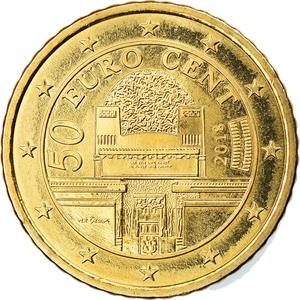The Fifty Euro Cents coin (€0.50) has a value of one half of a Euro and is composed of an alloy called Nordic Gold (89% copper, 5% aluminium, 5% zinc, and 1% tin). Like all other common circulation coins (from 1 cent to €2), the denomination is issued by the separate countries in the Eurozone and is legal tender in all of them, irrespective of which country has issued it. The denomination was introduced in 2002, when Austria retired the Austrian Schilling currency and introduced the Euro.
The coins have a common reverse designed by Luc Luycx in 1999 which showed a map of the European Union; it was changed in 2007 to reflect the enlargement of the Union, and later coins show all of western Europe. Each country has its own national obverse; the Austrian obverse was designed by Josef Kaiser.
Austrian Fifty Euro Cents feature the Secession Building Exhibition Hall in Vienna, symbolising the birth of Art Nouveau and a new age in the country. Austria is the only country which uses the Latin alphabet, and yet repeats the denomination on the national side of the coins - thus not adhering to a rule which only allows members of the Eurozone to show the denomination in their own language if it uses non-Latin script.
All Austrian coins are struck by the Austrian Mint in Vienna. | 



